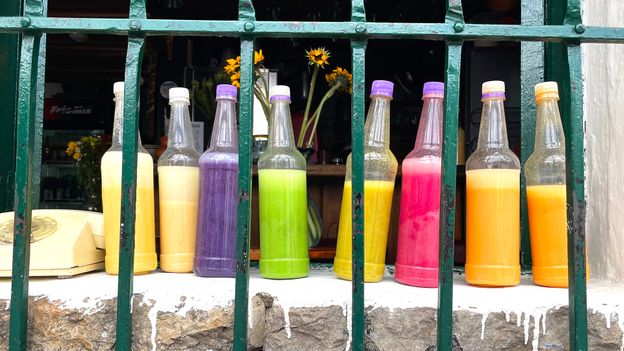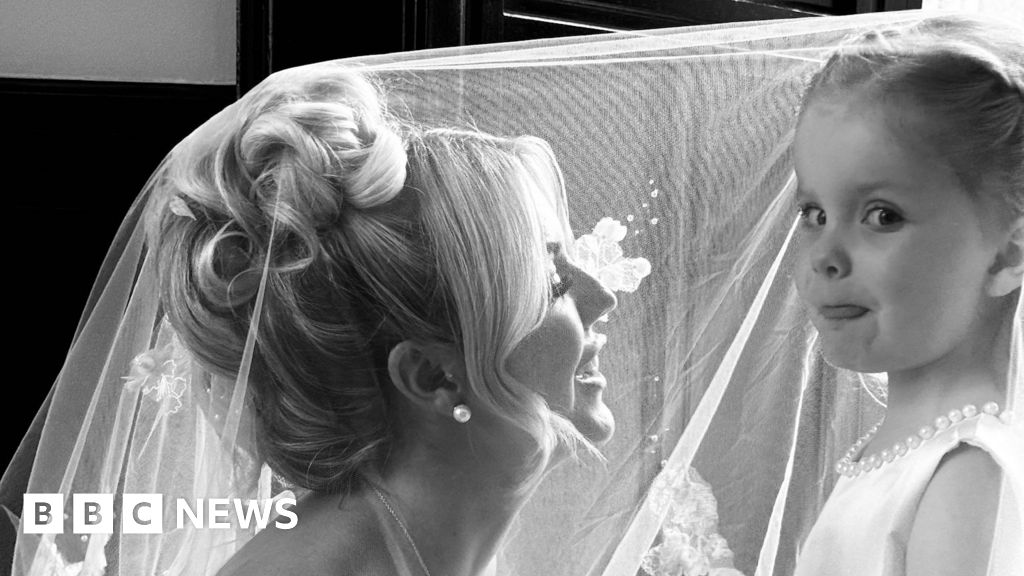“You know you’re breaking the law by drinking this?” teased my tour guide Andrea Izquierdo, as she placed a pitcher filled with a frothy, pale peach-coloured drink on the tasting table in front of us. We were at Casa Galeria, a restaurant in Bogot?’s Candelaria district – the historic and colourful centre of Colombia’s capital. The illegal substance she was about to serve me was chicha, an indigenous drink made from fermented corn that’s popular everywhere in Latin America.
I had heard that chicha was a beverage non-grata in Colombia, but I thought it was a joke. “Half the places around here sell chicha, including the street vendors on every corner,” I pointed out. “How can it possibly be illegal?”
Izquierdo moved the pitcher closer so I could closely examine the drink. I sniffed the liquid, whose aroma resembled beer, kombucha and juice all in one – as innocent as a libation can smell. “Believe it or not,” Izquierdo said, “but chicha has been banned since the late 1940s and it’s illegal in Colombia.”
She was right, of course. Once part of the indigenous traditions, the drink has been villainised for more than a century and was officially outlawed in 1949. It was said to make people ignorant and violent. It was said to ooze poisonous toxins during brewing. It was said to cause a disease named chichismo, a slow deterioration of the body and mind. For nearly the entire second half of the 20th Century, when the authorities found people making chicha, they confiscated the equipment, poured out the liquids and sent the brewers to jail. Those who were found drinking it risked imprisonment too.
“They didn’t take people away for years for those offences, but they could lock you up for six months to a year,” Izquierdo said.
Street vendors sell chicha in Colombia (Credit: Jeff Greenberg/Getty Images)
To trace how this dietary staple became synonymous with disease, one must first understand what was brewing in Colombian society – in more ways than one.
Centuries before Europeans arrived, the Indigenous Muisca people, who inhabited the high mountainous plateau where Bogot? is today, made chicha using their traditional process. The women chewed the corn and spat the mash into a clay bowl to start the fermentation initiated by their saliva. They then buried the covered bowl underground to keep it cool. Unearthed about two weeks later, it contained the thick yellowish, mildly alcoholic concoction.
“Notably not every woman could chew corn for chicha,” Izquierdo told me. “Only the wise women of the community were allowed to do it because they would pass their wisdom into the chicha so others could then ingest it.”
Chewing large quantities of corn took time and effort. That’s why originally chicha was produced in relatively small amounts and reserved only for certain special celebrations or ceremonies. “The women would sit and just chew and chew and chew, very conscious about what they were doing,” Izquierdo said. “They would start at least 15 days before the occasion so they could chew enough.” When ready, the communal chicha bowl was passed around and everyone took sips.
Tour guide Andrea Izquierdo explains the history of chicha in Colombia (Credit: Lina Zeldovich)
Later, people learned to mash corn by griding instead of chewing and started making chicha in greater amounts. It became a common beverage, so people drank it from calabazas, or calabash shells, they carried with them. Once dry, calabazas harden and can hold liquids, explained Izquierdo. She lined up a few little calabaza cups with strings attached to them on the table and offered me one. “Travellers would wear these cups around their necks, so when they arrived to a village or took a rest stop, people could pour them some chicha.”
By the 19th Century, the drink was an integral part of people’s diet in Colombia. Brewers produced it commercially. They soaked and ground the corn, mixing in cane juice, an ingredient that historically wasn’t part of the process but boosted fermentation and production. During that period, chicha was considered a healthy drink, according to Stefan Pohl-Valero, a historian at the School of Medicine and Health Sciences at the Universidad del Rosario in Bogot?. It was believed to give people strength.
At the end of the 1820s, a Colombian professor of medicine, Jos? Mar?a Merizalde, who studied chicha’s scientific properties, wrote that this “Colombian wine” definitely had a “nutritive” value. “The vigour that the [Andean] Indians acquire with chicha is not inferior to the one that the Europeans acquire with wine and beer,” Pohl-Valero quoted Merizalde in his 2020 paper, The Scientific Lives of Chicha. Besides vitamins, the drink is high in energy-boosting carbohydrates and sugars. “That may not be too good for us today, but the labourers who did physical work all day needed it,” Pohl-Valero said. Sometimes it was described as “liquid bread”.
People drank chicha from calabazas, or calabash shells (Credit: VW Pics/Getty Images)
Following Izquierdo’s instructions, I picked one of the round, dark brown calabazas and hung it around my neck like a pendant. I held up the cup, which she filled – and took a sip. Slightly sour and frothy, chicha could be best described as an acquired taste. It was also thickish so I could almost chew it – a liquid bread indeed. “Why was it villainised?” I asked.
In 1889, German immigrant Leo S Kopp started Bavaria Brewery in Bogota, the first large beer-making company in Colombia. Coincidentally or not, the same year, physician Liborio Zerda, who worked at the chemical laboratory of Bogot?’s school of medicine, claimed that chicha was toxic. Although he was Merizalde’s former student, his take on chicha was different. He saw it as deleterious because of “toxic, alkaloid or acrid principles, which are produced during the terrible fermentation of maize for the preparation of the chicha,” Pohl-Valero said, quoting Zerda in his study.
Zerda’s colleague, Josu? G?mez from the city’s Charity Hospital, joined in, coining a term chichismo – a chicha-caused disease characterised by “pigmentation of the skin”, a “sad, languid and stupid look”, and “putrid” body smell. The two medics proclaimed that chicha addicts, or enchichados, lost their energy and desire to work, slowly disintegrating – a problem of national proportions, leading to the “racial degeneration” of Colombian people.
“So, chicha was pathologised,” Pohl-Valero said.
It’s unclear whether that pathologising was government-sanctioned or not, but many Colombians believe that Bavaria Brewery had politicians in its deep pockets. Either way, the medical backing certainly helped Bavaria’s marketing campaigns, including posters that proclaimed, “No Mas Chicha, Consum Bier!” (No More Chicha, Drink Beer!). The pictures showed salubrious adults and even children sucking down the golden bubbly brew, which was properly fermented without spits or toxins and enjoyed in a hygienic way – in individual bottles or mugs rather than shared bowls.
Yet, chicha survived the harassment, persevering into the 20th Century until the liberal presidential candidate Jorge Eliecer Gait?n was assassinated in Bogot? in 1948, throwing the country into long-lasting civil unrest. A few politicians blamed the uprising on the “pathological condition of the poor that had resulted from the consumption of chicha,” Pohl-Valero said.
Posters were created to vilify chicha in marketing campaigns (Credit: Lina Zeldovich)
The Office for Inter-American Affairs, a United States agency promoting Pan-American trade during the 1940s, also had a hand in the anti-chicha fight. “They made a few very famous posters,” Pohl-Valero said. “And so now chicha was criminalised.”
“Chicha Makes You Stupid” proclaimed one poster. “Chicha Causes Crime!” stated another, featuring a blood-smeared knife. “The Jails are Full of People Who Drink Chicha!” read yet a third, depicting an incarcerated man and a crying woman. A year later, minister of hygiene Jorge Bejarano passed a law banning the production and sale of chicha in Colombia, and all chicher?as – places that brewed or served it – disappeared overnight.
I stretched out my empty calabaza and Izquierdo filled it up again. As I sipped the sourish concoction, letting it play on my palate, I couldn’t help but wonder how the tradition survived. “How did the people preserve the drink?” I asked.
“Chicha makers went underground,” Izquierdo explained – just like American bootleggers did during the prohibition. People couldn’t go to chicher?as, but they went to their friends’ and neighbours’ homes. “And of course, everyone knew the best chicha makers, so people would knock on their door and ask ‘do you have chicha?’.” As long as the brewers knew you, they sold you the drink. They put bottles inside paper bags, camouflaging them as loaves of bread.
“The big factories closed because they were easy to control, but families continued brewing,” Pohl-Valero added. “Paradoxically, the working-class neighbourhood that Bavaria Brewery built [around it] was where the production and consumption of chicha was happening.”
Although the ban is still in effect, chicha can be sold and consumed in Bogot?’s city centre (Credit: jackie ellis/Alamy)
It was also in the Bavaria neighbourhood that chicha first made its official comeback, about 40 years later. “Some time in the 1980s, the neighbourhood organised a festival where chicha was served for one day as a special occasion,” Pohl-Valero said. Not everyone was amused, he noted – many people felt it was a setback after decades of fighting the dangerous substance. But chicha came back the next year and the year after, slowly oozing its way back into the list of accepted beverages.
“It had to happen eventually,” Izquierdo said. “Because you cannot prohibit people to eat whatever they want to eat, or drink whatever they want to drink. You just cannot forbid something that’s so natural to people.”
The ban is still in effect, but today one can sell and consume chicha in the city centre, she explained. “But because it’s still outlawed, we can’t regulate its production,” she added. So, there are no official regulations that govern the process. The recipes are preserved by the generational families of chicha makers and may vary from one kin to the next. Some brewers add passionfruit, some mix in blueberries, others toss in pineapple. Many chicher?as boast an array of motley bottles, with colours spanning a rainbow.
“If there are no regulations, how does one know if a place is serving properly brewed chicha?” I asked.
“You have to know who made it,” Izquierdo answered. The multigenerational makers who preserved the recipes through decades of oppression take pride in their traditions. They carried the process through the dark times. They safeguarded the recipe when they risked imprisonment for using it. They passed it from grandmother to mother to daughter. After all this, you can be sure they’re making their best chicha today, Izquierdo said. “So, the only way to tell is to know the families.”
BBC.com’s World’s Table “smashes the kitchen ceiling” by changing the way the world thinks about food, through the past, present and future.
—
Join more than three million BBC Travel fans by liking us on Facebook, or follow us on Twitter and Instagram.
If you liked this story, sign up for the weekly bbc.com features newsletter called “The Essential List”. A handpicked selection of stories from BBC Future, Culture, Worklife and Travel, delivered to your inbox every Friday.



